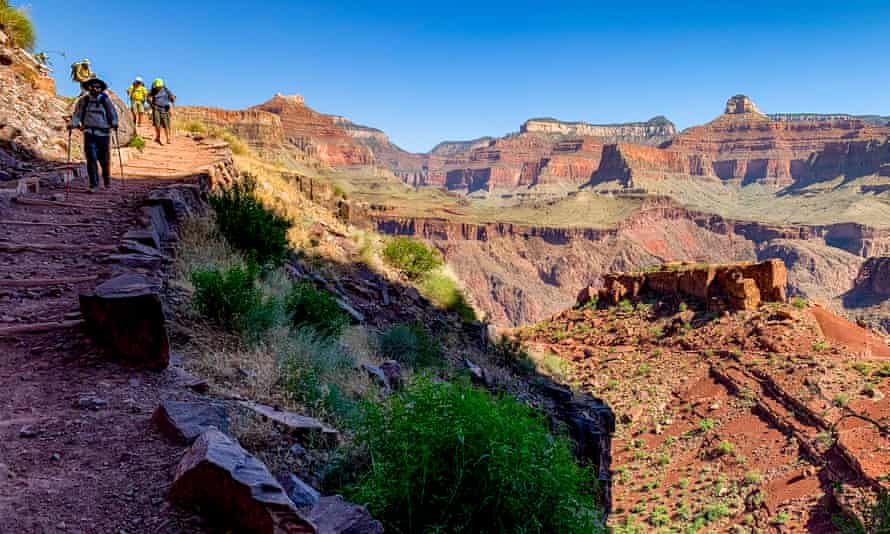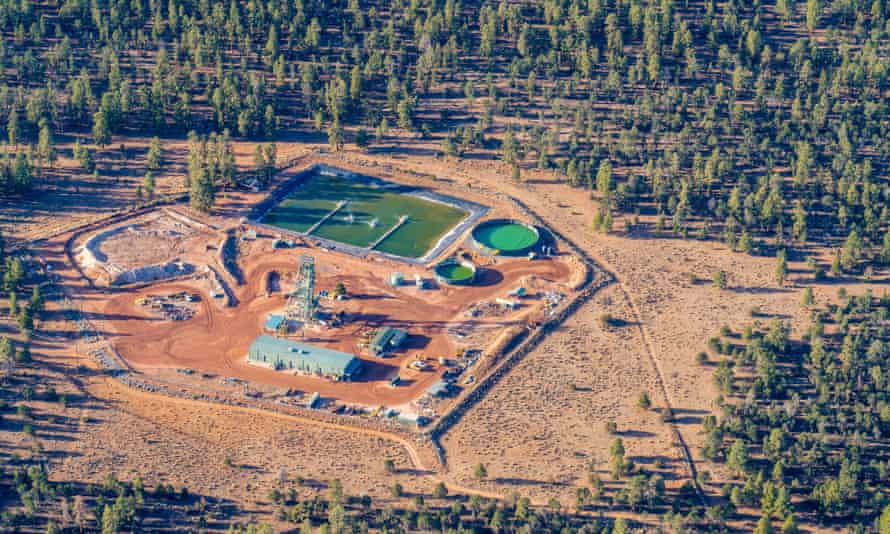
Sacred Native American sites such as the Grand Canyon and Bears Ears may seem a long way from the devastation unfolding in Ukraine. But as the US mulls a ban on Russian uranium, part of economic levers to stop Putin’s war, Indigenous communities living near US mines could pay the price.
John Barrasso, a senator from Wyoming, recently introduced a bill that calls for a ban on all forms of uranium imported from Russia. Uranium fuels America’s nuclear power plants, and about 20% of that comes from Russia, while close to another 30% is imported from the Russian allies of Kazakhstan and Uzbekistan.
Such a ban would shift American uranium production into overdrive. In an editorial in the Casper Star Tribune, Barrasso pointed out that the US has “vast uranium resources”, including in Wyoming, but 90% of the uranium used in nuclear power plants is imported. “Rather than letting our uranium sit in the ground, we ought to use it,” he wrote. A longtime advocate of the uranium industry, Barrasso also wrote that continuing to buy Russian uranium was funding “Putin’s killing machine”.
Mining companies now stand at the ready, with the possibility to ramp up production at sites near the Grand Canyon, Bears Ears national monument in Utah and at multiple locations in Barrasso’s home state of Wyoming. Many of the operations pose environmental and spiritual threats to Indigenous communities who live near the mines and have fought their existence for decades.
Amber Reimondo, the energy director of the not-for-profit Grand Canyon Trust, says the Senate’s proposal risks “perpetuating environmental injustices on our own soil”.
“If this ban is aimed at saving lives, the answer can’t just be to ramp up US uranium production,” Reimondosays. “The answer has to involve truly respecting and listening to communities on the frontlines of uranium production, especially Indigenous communities … Otherwise, this is not about protecting human life. It is about protecting profits.”
When the cold war began in the late 1940s, the federal government started a uranium boom in the US by offering generous incentives to private mining companies and guaranteeing a purchase price for ore. By the mid-1950s, more than 750 mines were in operation, mostly in and around Native American reservations in the south-west where there were rich uranium deposits. Until 1971, the US government was the primary purchaser of uranium as it built up its military arsenal. Many Native Americans worked in the mines, which were poorly regulated and offered few safety protections for employees or the environment.
After the dissolution of the Soviet Union, cheap uranium flooded the global market, which effectively shut down the more expensive US uranium mining operations. But with imported uranium prices on the rise after Russia’s invasion of Ukraine – up from $17 a pound in 2017 to nearly $60 a pound in the last few days – domestic mining companies see a unique opportunity.
Denver-based Energy Fuels Resources, the second largest uranium producer in the United States, told investors in mid-March that the war in Ukraine could improve the company’s bottom line. “With the recent events in Ukraine, security of supply in US of uranium is crucial,” said Mark Chalmers, the company’s president and CEO, in a webcast. He added that for the first time in years the suddenly favorable business environment had made it possible to pursue uranium sales contracts with “pricing and terms that return acceptable project margins”.
“We have a belief system that they don’t understand. In our stories, the mine is located is Mother Earth’s lungs”
Carletta Tilousi, Havasupai elder
According to Energy Fuels spokesperson Curtis Moore, the company has a total of six uranium mining facilities in Arizona, New Mexico, Utah and Wyomingthat are fully permitted and licensed, and could go into production pending a viable sales arrangement with a nuclear utility.
Pinyon Plain mine (formerly called Canyon Mine)has been waiting for such a moment for 35 years. Although the company has built most of the mine’s infrastructure and obtained all the permits, not a pound of ore has ever been extracted because uranium prices have remained too low.
The mine occupies 17 acres on Kaibab national forest, nine miles from the South Rim of Grand Canyon and three miles from Red Butte. The rust-colored landmark rising from the Coconino Plateau is the spiritual center for the Havasupai people who have lived in the Grand Canyon for more than 800 years. The 754-member tribe has been fighting the mine since it was first permitted in 1986. In addition to fears about environmental and health hazards, there are also significant spiritual harms caused by the mine that tribal members say are devastating but have been dismissed by federal courts, the mining company and government regulatory agencies.

“We have a belief system that they don’t understand,” says the Havasupai elder Carletta Tilousi who has been involved in fighting the mine for decades and also serves on Joe Biden’s White House environmental justice advisory council. “In our stories, that area where the mine is located is Mother Earth’s lungs. So when they dug the mine shaft, they punctured her lungs.”
In 2016, Energy Fuels completed digging a 1,400ft-deep mine shaft. The operation pierced an aquifer that has flowed into the mine shaft ever since. About 40m gallons of water with high levels of uranium and arsenic have been managed on the site, where a lined pond holds the water before it is sprayed into the air to evaporate. Environmentalists and the Havasupai argue that the toxic water could eventually make its way into a deep aquifer that supplies the tribe’s drinking water and feedssprings in Grand Canyon national park. If the mine begins extracting uranium ore, the possibility for contamination will become exponentially greater.
When asked about the controversy over Pinyon Plain mine and its potential impact on Indigenous communities, Moore attributed the negative claims to environmental groups. “There are some activists who like to spread a lot of misinformation about groundwater pollution or air pollution,” he said. “But it’s just not true.”
Reimondo points out that even if Energy Fuels is currently not in violation of regulations from the Arizona department of environmental quality, the water coming out of the mine shaft still contains levels of uranium and arsenic that is about 30 times the amount considered safe by the EPA for drinking water. And there is always the possibility that the pond holding all that water could spring a leak.
“The risk of an accident is theoretical with regulators until it actually happens,” says Reimondo.
The ore extracted from Pinyon Plain mine would be trucked to Energy Fuels’ White Mesa Mill, a processing facility in southeastern Utah adjacent to the Ute Mountain Ute community and near Bears Ears national monument. As the only operational uranium mill in the United States, White Mesa’s processing business is likely to significantly increase with more domestic uranium production. The 40-year-old mill also produces uranium by extracting it from industrial wastes, and stores leftover radioactive material on site.

Like the Havasupai, the Ute Mountain Ute are worried their drinking water could be contaminated by the mill. And they are afraid to gather traditional plants in the area or even let their children play outside when the air smells bad. In August 2021, the tribe passed a resolution declaring that White Mesa Mill should be closed in order to protect the health of the community. But that request has not been acted upon by Utah government officials.
“How can we make sure tribal members can get clean drinking water when radioactive waste is just a few miles away?” asks Manuel Heart, the Ute Mountain Ute tribal chairman.
Industry representatives counter that fears about uranium mining operations are misguided and based on bad practices from the cold war era rather than the modern technologies used today. “All the mines that would respond to this current demand have gone through the gauntlet of permitting with very high US standards,” says Scott Melbye, president of the trade group Uranium Producers of America. “The United States can do it a lot better, safer and cleaner than developed countries who don’t care about the environment or aboriginal communities. We are the world leaders for 21st-century mining practices in terms of health and safety.”
However, Reimondo of Grand Canyon Trust points out that health and safety regulations only focus on monitoring during a short time period, while exposed uranium can pose an environmental hazard for hundreds or thousands of years. The Pinyon Plain mine is anticipated to have an operational life of four to seven years followed by a post-closure monitoring program lasting seven years.
“The threat of a uranium mine doesn’t end when it closes,” she says. “In fact, that might be the start of the real threat because nobody is there any more.”
Hundreds of abandoned uranium mines remain on the Navajo reservation from operations spanning the 1950s to the 1980s when the US military built up its cold war arsenal. Cancer caused by contaminated ground water is common on the reservation and an ongoing recent study by the University of New Mexico found that many Navajo women and their babies have high levels of radioactive metal in their systems.
Uncertainty remains as to whether the uranium ban will come to fruition. According to Senator Barrasso’s spokesperson, the bill has not yet been scheduled for a committee hearing but “he will look for every opportunity to pass it into law”. And although Biden banned imports of Russian oil, gas and coal, he has not announced any policies regarding Russian uranium.
Regardless, the Havasupai, who call themselves “the guardians of the Grand Canyon”, are ready to fight.
“You may have taken the ground from underneath us but we are still here,” says Tilousi. “We are a small tribe with a very big voice.”
This article was amended on 30 March 2022. An earlier version said that Energy Fuels had “inadvertently” pierced an aquifer at Pinyon Plain mine that had “flooded” the shaft. In fact, the perched aquifer was pierced intentionally and the consequent flow of water is being continuously pumped out.